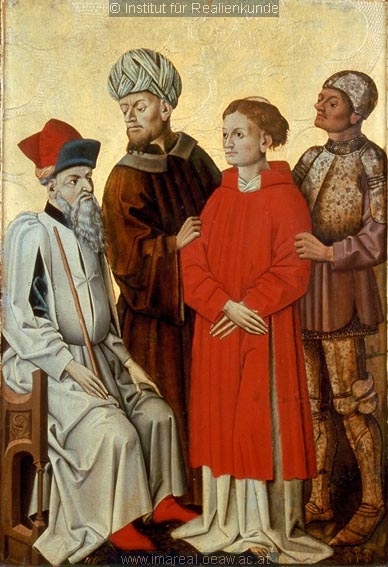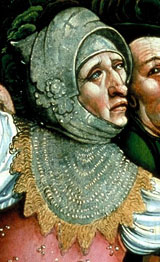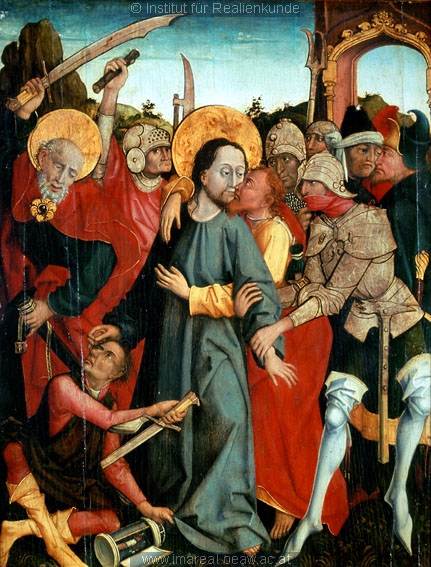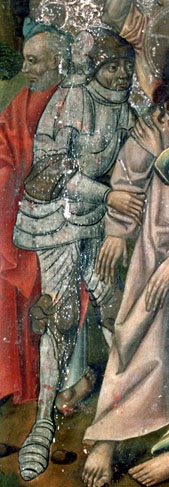
This 15th c. German painting seems to depict armour with characteristic staining/pitting from cleaned rust. At first I thought this might be foxing or mold of the paper/canvas, but it seems to be confined to the armour. This is the only historic depiction of rust I've run across, though surely there are more (?).
 Attachment: 98.35 KB
Attachment: 98.35 KB


Very interesting find Sean, nice researching! Detailed surfaces of armour in period art is not common thats for sure, detailed corrotion-marks even less so. But i think what we have illustrated here might be the surface of munitions-armour. If one compare with the surface of some of the 'black sallets' that hasnt been painted its quite similar. Altho i cant recall ever seeing armour for the body with such a rough surface.
Sean,
That's interesting. Do you know what event/people are being depicted?
That's interesting. Do you know what event/people are being depicted?
This depicts St. Stephen before a judge of the Sanhedrin on charges of blasphemy. The guard is mostly likely just one of the many nameless soldiers common in biblical scenes of this period. I've said it before but it bears repeating--This image is from a site that is a goldmine for details of arms, armour, clothes and accoutrements. I turned it up in a search for Material Objects, 1440-1510, "Kettenhemd" (mail shirt):
http://www.imareal.oeaw.ac.at/realonline/
Here's the complete caption information for this image (nothing here about rust--just a mention that the harness is grey):
Verhör des Hl. Stephan
Dieses Bild: 004974
Kunstwerk: Temperamalerei-Holz ; Einrichtung sakral ; Flügelaltar ; Brixen ; Stephan:04:001-023
Dokumentation: 1470 ; 1490 ; Freising ; Deutschland ; Bayern ; Diözesanmuseum
Anmerkungen: Albeins ; Erich Egg, Gotik in Tirol, Innsbruck 1985, S. 91f.
Handlung(en): richten, urteilen,
Person: Richter ; Mann ; sitzend
Teil: Haartracht ; grau ; kurz
Teil: Vollbart ; grau ; geteilt
Attribute: Richterstab ; ocker ; Holz
Kleidungsstück: Spitzhut , Turbanhut ; rot
Teil: Turbantuch ; gelb ; gewunden
Teil: Krempe ; blau ; aufgestellt , geteilt
Kleidungsstück: Rock ; weiß ; gegürtet , geknöpft
Teil: Halsausschnitt ; geschlitzt
Teil: Knopf ; weiß
Teil: Beutelärmel , Leerärmel , Hängeärmel ; gefältelt
Kleidungsstück: Untergewand ; blau
Kleidungsstück: Stiefel ; rot ; geschoppt
Person: Scherge ; Mann ; haltend (Hl. Stephan an Schulter)
Teil: Bart ; braun ; geteilt
Kleidungsstück: Turban ; weiß ; geflochten
Kleidungsstück: Rock ; braun
Teil: Trichterärmel
Teil: Kragen ; grau
Kleidungsstück: Untergewand
Teil: Stehkragen ; schwarz
Person: Hl. Stephan ; Geistlicher ; Mann ; Arme gekreuzt
Teil: Tonsur
Teil: Haartracht ; braun ; kurz
Kleidungsstück: Amikt ; weiß
Teil: Parura ; rot
Kleidungsstück: Dalmatik ; rot
Kleidungsstück: Albe ; weiß
Kleidungsstück: barfuß
Person: Gerüsteter ; Mann ; haltend (Hl. Stephan an Schulter)
Kleidungsstück: Beckenhaube ; grau
Kleidungsstück: Brustharnisch ; grau , ocker
Kleidungsstück: Kettenhemd ; grau , ocker
Kleidungsstück: Armzeug ; grau
Kleidungsstück: Waffenrock ; grau ; seitlich geschlitzt , kurz
Kleidungsstück: Beinzeug ; ocker
Teil: Kniebuckel
Kleidungsstück: Eisenschuh ; ock
Objekt: Stuhl ; braun ; Holz ; gezimmert , geschnitzt
Objekt: Wiese ; grün
Objekt: Wiesenpflanze
Objekt: Pilz(?)
Objekt: Hintergrund ; gold ; gemustert
Teil: Granatapfelmuster(?)
http://www.imareal.oeaw.ac.at/realonline/
Here's the complete caption information for this image (nothing here about rust--just a mention that the harness is grey):
Verhör des Hl. Stephan
Dieses Bild: 004974
Kunstwerk: Temperamalerei-Holz ; Einrichtung sakral ; Flügelaltar ; Brixen ; Stephan:04:001-023
Dokumentation: 1470 ; 1490 ; Freising ; Deutschland ; Bayern ; Diözesanmuseum
Anmerkungen: Albeins ; Erich Egg, Gotik in Tirol, Innsbruck 1985, S. 91f.
Handlung(en): richten, urteilen,
Person: Richter ; Mann ; sitzend
Teil: Haartracht ; grau ; kurz
Teil: Vollbart ; grau ; geteilt
Attribute: Richterstab ; ocker ; Holz
Kleidungsstück: Spitzhut , Turbanhut ; rot
Teil: Turbantuch ; gelb ; gewunden
Teil: Krempe ; blau ; aufgestellt , geteilt
Kleidungsstück: Rock ; weiß ; gegürtet , geknöpft
Teil: Halsausschnitt ; geschlitzt
Teil: Knopf ; weiß
Teil: Beutelärmel , Leerärmel , Hängeärmel ; gefältelt
Kleidungsstück: Untergewand ; blau
Kleidungsstück: Stiefel ; rot ; geschoppt
Person: Scherge ; Mann ; haltend (Hl. Stephan an Schulter)
Teil: Bart ; braun ; geteilt
Kleidungsstück: Turban ; weiß ; geflochten
Kleidungsstück: Rock ; braun
Teil: Trichterärmel
Teil: Kragen ; grau
Kleidungsstück: Untergewand
Teil: Stehkragen ; schwarz
Person: Hl. Stephan ; Geistlicher ; Mann ; Arme gekreuzt
Teil: Tonsur
Teil: Haartracht ; braun ; kurz
Kleidungsstück: Amikt ; weiß
Teil: Parura ; rot
Kleidungsstück: Dalmatik ; rot
Kleidungsstück: Albe ; weiß
Kleidungsstück: barfuß
Person: Gerüsteter ; Mann ; haltend (Hl. Stephan an Schulter)
Kleidungsstück: Beckenhaube ; grau
Kleidungsstück: Brustharnisch ; grau , ocker
Kleidungsstück: Kettenhemd ; grau , ocker
Kleidungsstück: Armzeug ; grau
Kleidungsstück: Waffenrock ; grau ; seitlich geschlitzt , kurz
Kleidungsstück: Beinzeug ; ocker
Teil: Kniebuckel
Kleidungsstück: Eisenschuh ; ock
Objekt: Stuhl ; braun ; Holz ; gezimmert , geschnitzt
Objekt: Wiese ; grün
Objekt: Wiesenpflanze
Objekt: Pilz(?)
Objekt: Hintergrund ; gold ; gemustert
Teil: Granatapfelmuster(?)
A more close-up pic at high resolution might help interpreting the surface of the depicted armour as being rust or something else ?
Fabric cover glued to the plate ? I'm not sure if this was done for all armour parts but some sallets seemed to be covered with fabric at times.
Could it be some form of inlays, gilding or etching and not rust ?
If it is rust maybe the story being portrayed explains it ? Could it be a right after battle in a heavy rain scenario and before the armour could be cleaned ? Although this would mean a level of realism in period paintings that is usually not seen ?
Anyway, looking for the right questions to ask as I don't have the answers. ;) :lol:
Fabric cover glued to the plate ? I'm not sure if this was done for all armour parts but some sallets seemed to be covered with fabric at times.
Could it be some form of inlays, gilding or etching and not rust ?
If it is rust maybe the story being portrayed explains it ? Could it be a right after battle in a heavy rain scenario and before the armour could be cleaned ? Although this would mean a level of realism in period paintings that is usually not seen ?
Anyway, looking for the right questions to ask as I don't have the answers. ;) :lol:
I, too, wondered if this represents a munitions harness. Most of the soldiers depicted in these kinds of paintings (crucifixion scenes, etc.) appear to be common infantrymen. That's one of the great reference values of the art. But why go to so much trouble depicting rust or hammer marks on the armour of a minor character? Since this soldier is a "bad guy" maybe the state of his armour has some kind of symbolic importance, indicating decay, corruption, carelessness, barbarity, etc.
Hi Sean
Great picture. I have tried to enhance it a bit and sort out what is depicted. It does seem to be a depiction of the surface of the armor. The only different explanation would be some metallic component of the pigment or use of a metallic leaf that has started to corrode. This can often be seen when silver has been used and it has all gone black.
This does not seem to be this. Not sure why the artist chose this route but glad he did. I checked the material about St Stephen's arrest and trial and there does not seem to be any specific element that would tie into an armor that is in this condition. There is not a lot of info in the descriptions. The only mention of anything is the verb used for his arrest has a tendency to indicate conflict so he may have not gone quietly.
I would not doubt that common guards,soldiers,mercenaries would have had armor in this condition often and that munitions material stored for any length of time would be similar in condition.
I suppose it may be a way to indicate the age of the event. They depict the people as contemporaries would expect them to be but the armor may be though of as older in style and well used ??
It would seem the easiest and simplest solution maybe this is a nice depiction of an armor in low end use from the time of the art.
Good find.
Craig
Great picture. I have tried to enhance it a bit and sort out what is depicted. It does seem to be a depiction of the surface of the armor. The only different explanation would be some metallic component of the pigment or use of a metallic leaf that has started to corrode. This can often be seen when silver has been used and it has all gone black.
This does not seem to be this. Not sure why the artist chose this route but glad he did. I checked the material about St Stephen's arrest and trial and there does not seem to be any specific element that would tie into an armor that is in this condition. There is not a lot of info in the descriptions. The only mention of anything is the verb used for his arrest has a tendency to indicate conflict so he may have not gone quietly.
I would not doubt that common guards,soldiers,mercenaries would have had armor in this condition often and that munitions material stored for any length of time would be similar in condition.
I suppose it may be a way to indicate the age of the event. They depict the people as contemporaries would expect them to be but the armor may be though of as older in style and well used ??
It would seem the easiest and simplest solution maybe this is a nice depiction of an armor in low end use from the time of the art.
Good find.
Craig
"capture of Christ" images can usually be relied upon to depict surly grunts, so I looked through those paintings at REALonline and found a few more interesting armour finishing details. The first two are from a single painting and depict very convincing polished but stained finishes). The figure in the second image also wears plate knee defenses (not shown here) with the same spotty finish. All armour in the third image is mottled.
Note the full plate harness with dark-finished joint defenses and sallet brow reinforcement. Not rust, but apparently deliberate browning or blackening.
 Attachment: 63.91 KB
Attachment: 63.91 KB

 Attachment: 58.16 KB
Attachment: 58.16 KB

 Attachment: 142.46 KB
Attachment: 142.46 KB

 Attachment: 71.87 KB
Attachment: 71.87 KB

Note the full plate harness with dark-finished joint defenses and sallet brow reinforcement. Not rust, but apparently deliberate browning or blackening.




Lovely paintings, and an interesting thread ~S~
I remember seeing a lot of period paintings of brown colored armor, which i assume is a form of 'bluing'? Or could it mean rust?
I remember seeing a lot of period paintings of brown colored armor, which i assume is a form of 'bluing'? Or could it mean rust?
| Jean Henri Chandler wrote: |
| Lovely paintings, and an interesting thread ~S~
I remember seeing a lot of period paintings of brown colored armor, which i assume is a form of 'bluing'? Or could it mean rust? |
Browning was used centuries later on muskets and is a stabilized form of rust like bluing but I don't know if plate armour might have been browned.
Also, in the paintings the stained armour could be well maintained armour that has been exposed to the elements and somewhat covered by patina. Although, I don't know if the patina would be left alone longterm as it does protect from rust or would it be repolished bright at the first opportunity ? This could be mostly just a preference for bright and polished armour even if leaving the patina alone might have been a better idea: Aesthetics versus function ?
It strikes me as more of a depiction of munitions grade armour with rough hammer marks or possibly even repairs. There is a lot of attention to lighting and shadows in the picture. The upper armour is not really brownish or darker as if rusted, and seems correctly depicted as being better illuminated than the leg harness that is in the shadow of the victim.
A very interesting thread and find!
If I recall correctly (and will readily admit my memory has shown itself to be faulty), there was an emphasis among northern painters on trying to depict the "real world" as observed in art as a religious devotion. i.e.: since God created the world we live in, it does disservice to God to not give careful attention to the details an artist sees and can depict.
There was a steady march of progress towards continued enhancement in detail starting with manuscript and devotional paintings that carried on over to larger altar-piece paintings. At least that continued through the time of Durer.
When an artist starts working in that manner, the tendency to rely on available materials and costumes dictates some limitations to what the artist can work with.
It's entirely possible that the harness he was working from (unless a noble was being depicted, it's unlikely that a fine suit of armor would be available) was a battle-worn or old set.
The sourcing of materials depicted by various artists sounds like another good thesis topic for an aspiring art historian with an interest in arms and armor.
Another point about this: although the artist has dealt with the materials (fabric, metal, etc.) very well, and indicated form and texture reasonably well, it appears that the details of depicting the finish on the materials escapes him. For example, it is not really possible to tell what kind of fabric is being shown, and the textures of skin are not dealt with except in a general way. So what we see as a finish on the armor may have been an attempt at coloring or an attempt at texture that did not go right. Stranger things have happened. Perfectly gifted artists have run up against a material that they could not depict (e.g.: see-through veils and other gauzy cloths) but made somewhat clumsy attempts to work through the depiction.
(At a later point in history, Carravagio's depiction of "The Death of the Virgin" would land him in hot water with The Church because the bare-footed Mother of Christ is shown with dirty feet - which would have been very natural for a bare-footed model)
If I recall correctly (and will readily admit my memory has shown itself to be faulty), there was an emphasis among northern painters on trying to depict the "real world" as observed in art as a religious devotion. i.e.: since God created the world we live in, it does disservice to God to not give careful attention to the details an artist sees and can depict.
There was a steady march of progress towards continued enhancement in detail starting with manuscript and devotional paintings that carried on over to larger altar-piece paintings. At least that continued through the time of Durer.
When an artist starts working in that manner, the tendency to rely on available materials and costumes dictates some limitations to what the artist can work with.
It's entirely possible that the harness he was working from (unless a noble was being depicted, it's unlikely that a fine suit of armor would be available) was a battle-worn or old set.
The sourcing of materials depicted by various artists sounds like another good thesis topic for an aspiring art historian with an interest in arms and armor.
Another point about this: although the artist has dealt with the materials (fabric, metal, etc.) very well, and indicated form and texture reasonably well, it appears that the details of depicting the finish on the materials escapes him. For example, it is not really possible to tell what kind of fabric is being shown, and the textures of skin are not dealt with except in a general way. So what we see as a finish on the armor may have been an attempt at coloring or an attempt at texture that did not go right. Stranger things have happened. Perfectly gifted artists have run up against a material that they could not depict (e.g.: see-through veils and other gauzy cloths) but made somewhat clumsy attempts to work through the depiction.
(At a later point in history, Carravagio's depiction of "The Death of the Virgin" would land him in hot water with The Church because the bare-footed Mother of Christ is shown with dirty feet - which would have been very natural for a bare-footed model)
Thought id add a picture of a munitions harness with similar surface as in the artwork;
And if anyone wants to contribute with photos of munitions-grade leg armour that would be interesting as well.
 Attachment: 95.25 KB
Attachment: 95.25 KB
[ Download ]
And if anyone wants to contribute with photos of munitions-grade leg armour that would be interesting as well.
[ Download ]
That's a very nice shot, W. Thanks for posting it. You're right--the surface is very similar to that shown in the painting. I can't help but laugh at the helmet, though. Now that is reconstruction! :lol: Maybe there's more of the original on the right side.
Page 1 of 1
You cannot post new topics in this forumYou cannot reply to topics in this forum
You cannot edit your posts in this forum
You cannot delete your posts in this forum
You cannot vote in polls in this forum
You cannot attach files in this forum
You can download files in this forum
All contents © Copyright 2003-2006 myArmoury.com — All rights reserved
Discussion forums powered by phpBB © The phpBB Group
Switch to the Full-featured Version of the forum
Discussion forums powered by phpBB © The phpBB Group
Switch to the Full-featured Version of the forum